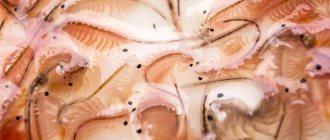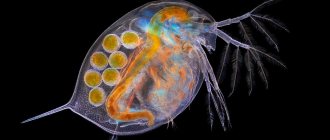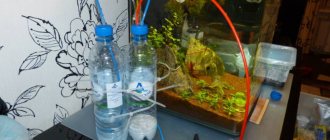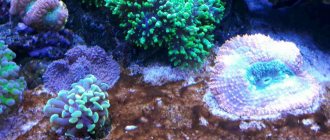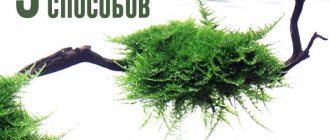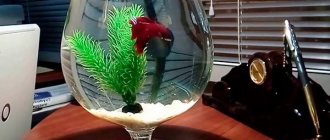It happens that aquariums are invaded and infested with “pest” organisms that cause concern among aquarists, although they are harmless in nature. Sometimes these fears are not unfounded, since the presence of these organisms in large numbers in the aquarium (which has the nature of an epidemic) is a sign of deterioration in the fish’s habitat. In addition, this indicates inattention to detail on the part of the aquarist: he does not check the live food in which they may be present, and collects decorative material in natural reservoirs inhabited by fish, which should not be done. Such pests are unpleasant to look at and create some inconvenience. Although they do not directly harm the fish, their presence is a warning sign and should not be ignored.
Water burros Asellus
Asellus water burros are aquatic crustaceans also called water lice. They bear some resemblance to woodlice, of which they are relatives. They can be brought into the aquarium along with live food (or as live food), and they colonize inaccessible crevices in decorative items, as well as the filter. They do not cause direct harm to fish, but can play the role of intermediate hosts for acanthocephalus (spiny-headed worms). These worms rarely infect aquarium fish, so there is no need to worry too much about this. However, a large population of Asellus aquatic burros indicates that the aquarium has heavy organic pollution, to which these creatures contribute further.
Scenery processing
Decorations made of wood, stone or metal, and stones for the aquarium are disinfected by boiling in boiling water for 15–20 minutes - this time is enough to destroy possible harmful bacteria and viruses that can harm the fish. Decorative elements made of plastic cannot be boiled, so a solution of potassium permanganate is used for bactericidal treatment.
Polychaete worms
These are annelids from the family Naididae, reaching a length of 2 cm. They are characterized by the presence of bristles (perhaps due to these bristles they are inedible for fish). Most often these are white or pink worms that reproduce by budding or laying eggs. They can be brought into the aquarium along with plants, in the shells of aquatic snails, or in water in which live food caught in the wild has been carried. In an aquarium, they can live in the soil layer or on its surface, feeding on detritus. Therefore, their presence in significant quantities is an indicator of poor aquarium hygiene and the danger to which the fish are exposed due to contamination. These worms themselves are harmless. Improving aquarium hygiene will bring their numbers under control and will benefit the fish by improving living conditions.
Seaweed
Algae are lower aquatic plants that, depending on the species, either attach to underwater surfaces or live freely in water. They can have different shapes and colors (green, brown, red, gray, yellowish). In appearance, they can resemble a slimy coating or fluffy tufts, form a carpet resembling moss, or long fibrous tufts (for example, the mud that we see in ponds in summer). True algae are different from so-called blue-green algae, which are scientifically classified as cyanobacteria.
The presence of algae is inevitable where water, nutrients and light are present simultaneously. All three elements are present in every aquarium, so the aquarist must learn to accept that algae is a natural and unavoidable part of the aquarium ecosystem. In the aquarium, as in nature, algae provide a number of benefits. They are a natural food for some herbivorous fish. Together with the microorganisms living on them, they are an excellent source of first food for fry. They reduce the amount of nitrates in water used as food. In addition, algae give completely bare decorative objects - for example, stones - a more natural look, because in natural bodies of water, stones are usually covered with algae. If algae growth is excessive, this is a warning of possible water quality problems.
Different aquariums are populated with completely different types of algae
Different aquariums are populated with completely different types of algae. Part of this depends on the lighting of the aquarium, with low lighting favoring the growth of brown slimy algae and bright lighting encouraging the growth of bright green algae.
Algae is thought to be particularly troublesome when it coats aquarium glass and plant leaves. However, it is not difficult to keep the front glass of your aquarium clean using a scraper or a magnetic glass cleaner. Algae can be left on those glasses of the aquarium that are not used for viewing. By remaining there, the algae will help remove nitrates and provide food for the fish. If you're an aquarist with a penchant for photography, the algae-covered back glass is an added benefit because it prevents flash light from being reflected.
In nature, it is completely normal for algae to cover the old leaves of aquatic plants. These leaves die and are successively replaced by new leaves. When algae on aquarium plants causes problems, it is usually because the algae is growing too quickly or the higher plants are not growing enough. Aquarists often make the mistake of reducing the intensity or duration of lighting in the aquarium in an attempt to curb algae growth. But instead, they inhibit the growth of higher plants and thereby exacerbate the problem even more! Healthy plants help control algae growth by competing with it for available nutrients.
Algae on aquarium glass
If it becomes necessary to remove algae from the sight glasses every few days, this means that the algae is growing too vigorously. This phenomenon occurs when there is an excess of nutrients. Algae becomes a real problem - it is a sign of high levels of nitrates or phosphates. This, in turn, can be caused by too much aquarium fertilizer intended to promote plant growth, but is more often an indicator of poor aquarium maintenance - overcrowding, overfeeding fish, insufficient water changes, excessive waste, or a combination of these factors. Tap water used for partial water changes in an aquarium may contain too much nitrates and other substances that serve as food for algae. Thus, it is not the algae themselves, but the cause of their excessive growth, whatever it may be, that requires attention! Otherwise, the health of the fish will be adversely affected - due to contamination of the aquarium, and not due to the algae itself!
Blooming water in an aquarium
Free-floating algae, which are not visible to the naked eye, sometimes multiply to the point that the water becomes cloudy and resembles pea soup. This is the so-called “water bloom”. This phenomenon can be observed in ponds in summer, but it can also occur in an aquarium if it is illuminated for a long time by bright sunlight. And this problem is also an indicator of high levels of organic pollution.
Although there are special aquarium products available on the market to kill algae, the solution to this problem, which seems too easy, is not really a solution. The death and decomposition of large amounts of algae can overload the filtration system and further aggravate the pollution problem that is causing the algae outbreak. Even if this does not happen, dead algae will further increase the organic content of the aquarium. Therefore, when algae colonizes the aquarium again (and this inevitably will happen), then the problem will become even more acute than the first time. Repeated applications of algae control chemicals and biological loading will almost certainly have adverse effects on fish and higher vegetation. Therefore, it is better to identify and eliminate the cause of excess algae, and if their growth is normal, consider them friends rather than enemies.
Girinocheilus are “algae eaters”
Some fish—such as Gyrinocheilus aymonieri and some suckermouth catfish—are known algae eaters, so they can be used to control algae growth. However, this method does not eliminate the need to maintain a low concentration of organic waste in the aquarium.
Swimming beetle
The head of the larva of a swimming beetle is equipped with sickle-shaped jaws and it grabs prey with them, letting in a paralyzing liquid through the channels, after which it regurgitates enzymes from the stomach into the wound of the victim that dissolve tissue to a liquid state and sucks out this liquid. And so on until there is practically nothing left from the extraction. The swimming beetles themselves tear their prey into pieces and eat it greedily. Cases have been described in which swimming beetles and their larvae destroyed almost all juvenile fish in natural reservoirs and spawning ponds. The larvae of the diving beetle at an early stage of development are small, can go unnoticed by the aquarist and are brought into the aquarium with bloodworms and crustaceans.
Dangerous pests that destroy fish are aquatic insects such as smoothies, ranatras, water mites, water mites, water striders, water striders, aphelochirus water bug and larvae of water scorpion, water-loving beetle, and water beetle.
All of these animals are large and visible to the naked eye, therefore, by exercising some caution, carefully sorting and carefully examining live food, you can avoid pests from entering the aquarium.
But, unfortunately, disasters in the aquarium, which can be equated to inevitable, are not limited to this.
Copepods
Copepods are small aquatic crustaceans. Most of them are harmless to fish. Some free-living species, such as Cyclops, are used as live food. At the same time, representatives of some species of copepods are parasitic on fish.
Cyclops - used as live food
Free-living, harmless copepods are usually translucent and reach a length of 3 mm. They move in short leaps, but can also lie on underwater surfaces, including on the glass of an aquarium, where they are introduced either intentionally (as live food) or accidentally (on plants). Few manage to survive in an aquarium for a long time - for most fish this is a real delicacy. True, large fish do not pay attention to them - after all, they are too small and should not be eaten. Thus, contamination of an aquarium with free-living copepods can only occur if the fish do not eat them - either because they are unsuitable food, or because the fish are so unwell that they have lost interest in even such a tempting food source . This may be due to environmental pollution (heavy organic load). If copepods begin to reproduce in the aquarium, it means there is organic pollution.
If you eliminate the problem that caused this behavior of the fish, then the fish will solve it themselves with great pleasure.
Controlled parameters
The most important thing is to bring the parameters of the liquid medium back to normal, because otherwise why would settling be carried out? The most important characteristics are temperature, acidity and hardness. Let's look at them in more detail.
Temperature
The temperature in the aquarium must be constant - any changes are prohibited, especially in winter and summer.
All types of aquarium fish are divided into three groups:
- relatively cold-loving (goldfish and telescopes) - prefer temperatures of 18-23 °C;
- cold- and heat-resistant - prefer the “golden mean” (22-26 °C), most species belong to this group;
- heat-loving (discus, labyrinth) – 27-31 °C.
It is very important to settle the water in the room where the aquarium is located in order to minimize temperature changes.
Acidity
If we follow the methodology that came to us from chemistry, then pH (hydrogen index) reflects the reaction of the environment - acidic or alkaline. An environment with pH = 7 is considered neutral. Anything lower is acidic, anything higher is alkaline.
Most often, aquarium inhabitants need a slightly acidic (pH = 6-7) or neutral environment. Only rare species, for example, culya or eels, like slightly alkaline (pH = 7-7.9) liquid.
Cruelty
This indicator characterizes the content of salt ions in water. The greatest influence is exerted by magnesium and calcium salts.
Classification of the environment by hardness:
- very hard (dH index = 0-4);
- soft (dH = 5-8);
- medium (dH = 9-16);
- hard (dH = 17-32);
- very hard (dH 33 and above).
The hardness in the aquarium should be within the standard range of 3-15 units.
Moreover, each inhabitant needs certain conditions:
- shellfish require increased hardness (more than 15) so that calcium is not washed out of the shells;
- viviparous fish feel good at dH = 10;
- for caviar the norm is dH = 7-10;
- for neon – dH = 6;
- Some plants, such as ferns and sagittaria, need a hardness of 10-14 units.
Hardness cannot always be significantly reduced by settling, so it is recommended to carry out tests before adding liquid to the aquarium of pets that require a soft environment.
Cyanobacteria
Cyanobacteria or blue-green algae in the aquarium
This is a group of microorganisms that causes the growth of an algae-like substance. Aquarists call it “blue-green algae.” The appearance of such “algae” is associated with high levels of nitrates and phosphates. True, not all aquariums with a large amount of organic waste are filled with these “algae”. In one night they can cover all decorative objects in the aquarium, including the soil, with a slimy bluish-green coating. There is no evidence that they cause direct harm to adult fish (but they can be harmed by poor water quality, which causes rapid proliferation of cyanobacteria). However, these “algae” can very quickly cover and suffocate fry lying on the ground or decorative objects. In addition, they can completely cover plants and destroy them.
It is very difficult to completely get rid of blue-green algae. Subsequently, at the slightest deterioration in water quality, they can again begin to multiply rapidly. The only way out is to reduce the amount of organic waste and filter out as much of this green matter as possible every time during the next partial water change. Unfortunately, blue-green algae seems completely unpalatable to fish. It is said that sand snails feed on these algae, but none of the authors of this article can confirm this based on their own experience. In addition, these snails create no less nuisance than the cyanobacteria themselves.
Hydras
Hydras in the aquarium 1
These small coelenterates are freshwater relatives of sea anemones. They can be from 2mm to 2cm in length (including tentacles). They have the shape of a stem, topped at one end with tentacles, while the other end is attached to a solid base. All these signs make it possible to unmistakably recognize them. However, sometimes they shrink into tiny jelly-like balls. Their color can vary from cream to gray or light brown. (There are hydras with a pleasant green color, which can easily be mistaken for algae.).
Hydras (Hydra) sometimes end up in the aquarium along with live food or decorative items collected from nature. Subsequently, they settle on some objects or aquarium glass and represent additional interesting objects, almost as charming as the main inhabitants of the aquarium.
Hydra (Hydra) appearance, close-up
Hydras are safe for adult fish, but they can catch fry and other small fish, as well as small particles of fish food. Sometimes their numbers reach such a level that they become real pests. Like many other pests, they indicate problems with aquarium maintenance.
Hydra in aquarium 2
To completely destroy hydras, you have to completely empty the aquarium, scrape all its surfaces, wash gravel, decorative items and underwater equipment in a hot 2-5% saline solution at a temperature above 40 ° C. If the aquarium is planted with plants, then these plants are unlikely to respond well to cleaning in hot salty water! Therefore, it is better to use an alternative method, which consists in removing all the fish from the aquarium (as well as snails, if they are desirable inhabitants of the aquarium) into some temporary room and raising the water temperature in the aquarium to 42 ° C for half an hour. During heating, the filler that serves as a substrate for bacteria should be removed from the internal filters, but it is better to leave the filters in place, because hydra attaches to their surface. External filters should be turned off, but not for more than an hour, otherwise the bacterial population may die due to lack of oxygen. Then the aquarium should be allowed to cool down to normal temperature or cooled by partially changing the water and adding cold water. After this, you can start the fish (and snails) again and restore filtration.
In an aquarium populated with fish, the hydra population can be controlled by dissolving table salt in the water - you should get a 0.5% saline solution. This solution should be maintained for about a week, and then gradually get rid of the salt through repeated partial water changes. This method can only be used if all fish tolerate this salinity well. Otherwise, you will have to regularly clean the glass of the aquarium, filter out separated hydras, and remove stones and other solid decorative objects from the aquarium and process them in hot salt water.
Some fish species feed on hydras, such as gourami
Some species of fish feed on hydras (especially gourami, as well as young cichlids “grazing” on the rocks). Therefore, they can be used to control the hydra population, but only if these fish are suitable inhabitants for the aquarium in question.
Disinfection of an existing aquarium
An existing artificial pond with fish is treated with antibacterial substances. To make the tank disinfected, a solution with penicillin (10 mg/2 l) is used, and the procedure itself takes 72 hours. There is no need to worry about the flora: aquarium plants will not die. If the fish suddenly died in the tank, the treatment is carried out using a bactericidal lamp, turning on the device for 15 minutes for three days in a row.
Roundworms (nematodes)
This is a large group of thread-like worms, also called roundworms. Among them there are both free-living and parasitic species. Non-parasitic nematodes are red-brown worms with a non-segmented body, 1-3cm long. Sometimes they colonize the substrate and biological filter. They can be brought into the aquarium along with live food, and they are completely harmless. If they become too numerous, this indicates that adjustments are needed in aquarium hygiene and fish feeding regimen. These improvements are the only thing needed to reduce nematode numbers.
Shelly crustaceans
Ostracoda barnacles are bean-shaped crustaceans that reach a length of 4 mm. Sometimes you can see them scurrying around on the substrate, like tiny moving specks. These creatures are yellowish or black-brown in color. They attach their eggs to plants, so they can be accidentally introduced into the aquarium along with plants, as well as live food. They are found in small numbers in aquariums, but if aquarium hygiene leaves much to be desired, they can begin to multiply rapidly and become a real disaster. Thus, although barnacles are harmless, their presence indicates an environmental or nutritional problem with the fish. These problems can have adverse effects on fish. Improving aquarium care is a solution to both problems at the same time. It allows you to control the number of these animals and eliminate the causes of their rapid reproduction.
Planarians
Planarians are harmless, non-parasitic flatworms that often strike fear into the hearts of aquarists, as they are mistaken for parasites like leeches. They usually reach a length of 2-10 mm and are creamy white, gray or brown in color. Light planaria appear translucent when placed on the glass of an aquarium, while dark planaria look like tiny slugs. Characteristic features are a V-shaped head and a slow gliding movement along the surfaces of the aquarium.
Planaria can be unintentionally introduced into the aquarium along with aquatic plants or live food. In an aquarium there may be a small and completely invisible population of planarians living in the ground or on its surface. Sometimes their numbers become too large, and then you can see them crawling along the front glass of the aquarium or swimming freely in the water. Such rapid reproduction is an indicator of overfeeding of fish. Uneaten food is consumed by planarians, whose population grows at an explosive rate. It is necessary to review the feeding regime of fish and improve water quality if it has suffered due to overfeeding.
Planaria in an aquarium, appearance
Planaria problems often occur where large fish feed on food that disintegrates in their mouths. After this, a whole rain of food particles flies out of the gills and falls to the bottom. These particles are too small to be of interest to large fish. In such cases, it may not be the quantity, but the type of feed that is the real problem. A possible solution is to change the diet or keep fish in the aquarium, which have a habit of digging in the substrate and cleaning up anything that falls from above.
Some fish species, such as gouramis, eat planaria and thereby control their numbers. However, this method of control does not avoid other hazards, particularly contamination resulting from uneaten feed. Therefore, it should not be considered as an optimal solution to the problem.
Is it worth using?
Spring water is often characterized by the following parameters:
high levels of carbonate hardness;- slightly alkaline acid-base state;
- high mineralization;
- absence of chemical elements, compounds;
- if the water comes from artesian sources, it does not contain pathogenic bacteria.
Due to its purity, the water does not need to be subjected to heat treatment. It is suitable for fish. However, under conditions of such pH and carbonate hardness, only a part of the species can survive. For example, cichlids. If you soften the water, it will work for many other species.
Snails
Snails in an aquarium can turn from helpers into pests.
Some aquarists deliberately introduce aquatic snails into the aquarium so that they serve as “cleaners” and clean up leftover food. Sometimes snails get into the aquarium by accident - usually on plants. But no matter how the snails got into the aquarium, if they later turn out to be unwanted, removing them from there is not at all easy. This is especially true for the viviparous snail called Melania tuberculata. These snails live in the ground, where they can reproduce very intensively, and in such a way that the aquarist will have no idea that they are there.
Melania sand snail lives in the soil of the aquarium
The presence of a large number of snails is an indicator of an unhealthy aquarium. For snails to live, they must not only find enough organic matter to feed on, but also consume oxygen and produce organic waste. Some of them eat fish eggs. Snails caught in the wild or in ornamental ponds can introduce a variety of parasites into the aquarium, for which they act as intermediate hosts.
Snail populations can be kept within reasonable limits by regularly removing all snails that can be seen. For example, you can collect them with a net or filter them. Large specimens can be caught individually by hand. It is better to remove snails after turning off the lights in the aquarium, since most snails are active at night. Ground snails leave it at night to look for food on decorative objects and glass of the aquarium.
Snail from the wild
There are special products on sale for killing snails, but their use in aquariums inhabited by fish is undesirable. Most of these shellfish control products contain copper, which is toxic to fish, so an excessive dose can be fatal. Snail corpses can seriously pollute an aquarium, especially where the main problems are caused by sandy melania. Even if this chemical is applied at night, there will likely be countless dead snails left in the substrate. If you are still convinced that such a product needs to be used to kill sand snails, the fish should be transferred to another room. After this, you need to treat the aquarium, then thoroughly clean it and reinstall it, adding a new substrate.
To avoid accidentally introducing snails, it is perfectly acceptable to treat the plants with a shellfish killer before planting them in the aquarium. Remember that tiny snails may be missed when visually checking plants. Do not buy fish from aquariums that contain sand melania. If they get into one of your aquariums, keep it in quarantine until they are completely destroyed, because tiny newborn snails can very easily end up as stowaways in nets, fish bags, siphon tubes, etc. items of equipment.
Karpoed
The fight against carp eaters is quite difficult and is mainly designed for the mechanical separation of parasites. The affected fish are placed in a damp swab and the parasites are removed with thin tweezers. You can then treat the wound with a healing solution (0.1% aqueous solution of potassium permanganate: 1 gram of crystalline potassium permanganate per 1 liter of water). It is necessary to apply a cotton swab to the affected area (it is made by wrapping a piece of cotton wool around a match with a cut off sulfur head) soaked in this solution; after which the fish should be immediately released into an aquarium unloaded with carp eaters.
The main methods of control are based on knowledge of the nature of the development of the parasite. It is necessary to leave the aquarium without fish and raise the temperature in it to 26 ° C, light it well and keep it like that for a week.
Do not fish for food during the hot season in bodies of water where fish live. Carefully review the food caught and purchased at the market.
It is also necessary to look through and sort the laid out food for the reason that along with it, other, no less dangerous, fish pests can be brought into the aquarium. Some of them, for example, the larvae of swimming beetles, dragonflies, naiads, suitable for feeding adult cichlids and other large predatory fish, are completely unacceptable in an aquarium with small species and especially juveniles. One dragonfly larva, undetected by the aquarist, can destroy all the fry and kill adult fish, such as neons.
Tubifex Tubifex
Tubifex Tubifex are commonly used as live fish food despite the fact that they can introduce some disease into the aquarium. If tubifex worms are thrown into an aquarium that has soil in it, some of them may burrow into it and avoid being eaten. This can also happen if the fish are fed from a special feeder and too many tubifex worms are fed at one time. Those tubeworms that remain uneaten will eventually crawl out of the feeder and fall to the bottom. As a result, a whole colony of tubifex worms is formed in the soil - small red-brown worms, partially protruding from the substrate. The best solution is to stop feeding the fish. When the fish get hungry due to the lack of easier prey, they will take the trouble to catch these worms and soon solve the problem themselves.
Why do you need to defend
The water is settled to purify it from harmful insoluble impurities that easily settle to the bottom.
In addition, a number of other processes occur during settling:
- gaseous harmful impurities evaporate;
- the water becomes softer (if you then properly separate the sediment);
- Due to the change in hardness, the pH shifts slightly closer to neutral.
Below we will look at exactly what harmful impurities are removed by settling.


